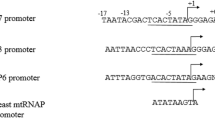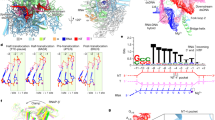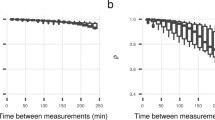Summary
Compilation and analysis of all bacterial sequences which are aligned by their transcription initiation sites show a dramatic behavior of the four nucleotides. Large peaks of T and A are observed. This highly nonrandom distribution is likely to affect the DNA geometry in addition to affecting the strength of binding between the two DNA strands. Following this site, the G and C rise above their overall bacterial mean. Alignment by transcription termination sites indicates that this behavior continues till the mRNA 3′ termini. At this site the concentrations of A and T rise again above the mean. Analysis of the distributions of the 256 quartets in the 1000 nucleotide regions surrounding both transcription initiation and termination sites has been carried out. Some A/T combination sequences may serve as signals to the bacterial transcription machinery, in addition to the well-established T T G A C A and T A T A A T at positions −35 and −10, respectively, and a run of Ts at the transcription termination site. The frequent occurrences of (dA)/(dT) runs in the vicinity of these sites may result in curved DNA structures, affecting recognition and the nature of the interaction between the RNA polymerase and the DNA.
Similar content being viewed by others
References
Arnott S, Chandrasekaran R, Hall IH, Puigjaner LC (1983) Heteronomous DNA. Nucleic Acids Res 11:4141–4155
Bossi L, Smith DM (1984) Conformational change in the DNA associated with an unusual promoter mutation in an tRNA operon ofSalmonella. Cell 39:643–652
Brendel V, Trifonov EN (1984) A computer algorithm for testing potential prokaryotic terminators. Nucleic Acids Res 12: 4411–4427
Briat J-F, Chamberlin MJ (1984) Identification and characterization of a new transcription termination factor fromEscherichia coli. Proc Natl Acad Sci USA 81:7373–7377
Collins FS, Metherall JE, Yamakawa M, Pan J, Weissman SM, Forget BG (1985) A point mutation in theAgamma-globin gene promoter in Greek hereditary persistence of fetal hemoglobin. Nature 313:325–326
Diekmann S, Wang JC (1985) On the sequence determination and flexibility of the kinetoplast DNA fragment with abnormal gel electrophoretic mobilities. J Mol Biol 186:1–11
Gelinas R, Endlich B, Pfeiffer C, Yagi M, Stamatoyannopoulos G (1985) G to A substitution in the distal CCAAT box of theAgamma-globin gene in Greek hereditary persistence of fetal hemoglobin. Nature 313:323–325
Gilbert W (1976) In: Losick R, Chamberlin M (eds) RNA polymerase. Cold Spring Harbor Laboratory, Cold Spring Harbor NY, pp 193–205
Hagerman PJ (1984) Evidence for the existence of stable curvature of DNA in solution. Proc Natl Acad Sci USA 81:4632–4636
Hagerman PJ (1985) Sequence dependence of the curvature of DNA: a test of the phasing hypothesis. Biochemistry 24:7033–7037
Hagerman PJ (1986) Sequence directed curvature of DNA. Nature 321:449–450
Hawley DK, McClure WR (1983) Compilation and analysis ofEscherichia coli promoter DNA sequences. Nucleic Acids Res 11:2237–2255
Jernigan RL, Sarai A, Ting K-L, Nussinov R (1986) Hydrophobic interactions in the major groove can influence DNA local structure. J Biomol Str Dyn 4:41–48
Jernigan RL, Sarai A, Shapiro B, Nussinov R (1987) Relationship between curved DNA conformations and slow gel migration J Biomol Str Dyn 4:561–567
Kingston RE, Chamberlin MJ (1981) Pausing and attenuation of in vitro transcription in the rrnB operon ofE. coli. Cell 27:523–531
Koo H-S, Wu H-M, Crothers D (1986) DNA bending at adenine thymine tracts. Nature 320:501–506.
Lamond AI, Travers AA (1985a) Stringent control of bacterial transcription. Cell 41:4–8.
Lamond AI, Travers AA (1985b) Genetically separable functional elements mediate the optimal expression and stringent regulation of a bacterial gene. Cell 40:319–326
Landy A, Ross W (1977) Viral integration and excision: structure of the lambda att sites. Science 197:1147–1160
Lennon GG, Nussinov R (1984) Homonyms, synonyms and mutations of the sequence/structure vocabulary. J Mol Biol 175:425–430
Levene SD, Crothers DM (1983) A computer graphics study of sequence-directed bending of DNA. J Biomol Str Dyn 1: 429–435
Levene SD, Wu H-M, Crothers DM (1986) Bending and flexibility of kinetoplast DNA. Biochemistry 25:3988–3995.
Lilley D (1986) Bent molecules how and why? Nature 320:487–488
Maniatis T, Ptashne M, Backmann K, Kleid D, Flashman S, Jeffrey A, Maurer R (1975) Recognition sequences of repressor and polymerase in the operators of bacteriophage lambda. Cell 5:109–113.
Martin FH, Tinoco I Jr (1980) DNA-RNA hybrid duplexes containing oligo(dA:rU) sequences are exceptionally unstable and may facilitate termination of transcription. Nucleic Acids Res 8:2295–2299
McCall M, Brown R, Kennard O (1985) The crystal structure of d(G-G-G-G-C-C-C-C) a model for poly(dG)·poly(dc). J Mol Biol 183:385–396
McKnight SL, Kingsbury R (1982) The transcriptional control of a eukaryotic protein-coding gene. Science 217:316–324
Miller JH, Reznikoff WS (eds) (1978) The operon. Cold Spring Harbor Laboratory, Cold Spring Harbor NY
Nussinov R (1984a) Promoter helical structure variation at theE. coli polymerase interaction sites. J Biol Chem 259:6798–6805
Nussinov R (1984b) Strong doublet preferences in nucleotide sequences and DNA geometry. J Mol Evol 20:111–119
Nussinov R (1984c) Doublet frequencies in evolutionary distinct groups. Nucleic Acids Res 12:1749–1763
Nussinov R (1985) Large helical conformational deviation from ideal B-DNA and prokaryotic regulatory sites. J Theor Biol 115:179–189
Nussinov R, Owens J, Maizel JV Jr (1986) Sequence signals in eukaryotic upstream regions. Biochim Biophys Acta 866:109–119
Platt T (1981) Termination of transcription and its regulation in the tryptophan operon ofE. coli. Cell 24:10–23
Pribnow D (1975) Nucleotide sequence of an RNA polymerase binding site at an early T7 promoter. Proc Natl Acad Sci USA 72:784–788
Roberts JW (1969) Termination factor for RNA synthesis. Nature 224:1168–1174
Rosenberg M, Court D (1979) Regulatory sequences involved in the promotion and termination of RNA transcription. Annu Rev Genet 13:319–353
Ross W, Landy A (1982) Bacteriophage lambda int protein recognizes two classes of sequence in the phageatt site: characterization of the arm-type sites. Proc Natl Acad Sci USA 79:7724–7728
Sarma MH, Gupta G, Sarma RH (1985) Untenability of the heteronomous DNA model for poly(dA)·poly(dT) in solution. This DNA adopts a right-handed B-DNA duplex in which the two strands are conformationally equivalent. A 500 MHz NMR study using one dimensional NOE. J Biomol Str Dyn 2:1057–1084
Satchwell SC, Drew HR, Travers AA (1986) Sequence periodicities in chicken nucleosome core DNA. J Mol Biol 191:659–675
Schaller H, Gray C, Hermann K (1975) Nucleotide sequence of an RNA polymerase binding site from the DNA of bacteriophage Fd. Proc Natl Acad Sci USA 72:737–741
Shih M-C, Gussin GN (1984) Differential effects of mutations on discrete steps in transcription initiation at the λ Pre promoter. Cell 34:941–949
Siebenlist U (1979) Nucleotide sequence of the three major early promoters of bacteriophage T7. Nucleic Acids Res 6: 1895–1907
Siebenlist U, Simpson RB, Gilbert W (1980)E. coli RNA polymerase interacts homologously with two different promoters. Cell 20:269–281
Travers A (1980) A tRNA tyr promoter with an altered in vitro response to ppGpp. J Mol Biol 141:91–97
Trifonov EN (1986) Curved DNA. CRC Crit Rev Biochem 19: 89–106
Wada A, Suyama A (1986a) Homogeneous double-helix-stability in individual genes. In: Sarma RH (ed) Proceedings of the 4th conversation in the discipline of biomolecular stereodynamics. Adenine Press, New York, pp 255–269
Wada A, Suyama A (1986b) Local stability of DNA and RNA secondary structure and its relation to biological functions. Prog Biophys Mol Biol 47:113–157
Wu H-M, Crothers DM (1984) The locus of sequence directed and protein induced DNA bending. Nature 308:509–513
Zahn K, Blattner FR (1985) Sequence induced DNA curvature at the bacteriophage lambda origin of replication. Nature 317: 451–453
Author information
Authors and Affiliations
Rights and permissions
About this article
Cite this article
Nussinov, R., Barber, A. & Maizel, J.V. The distributions of nucleotides near bacterial transcription initiation and termination sites show distinct signals that may affect DNA geometry. J Mol Evol 26, 187–197 (1987). https://doi.org/10.1007/BF02099851
Received:
Revised:
Accepted:
Issue Date:
DOI: https://doi.org/10.1007/BF02099851




